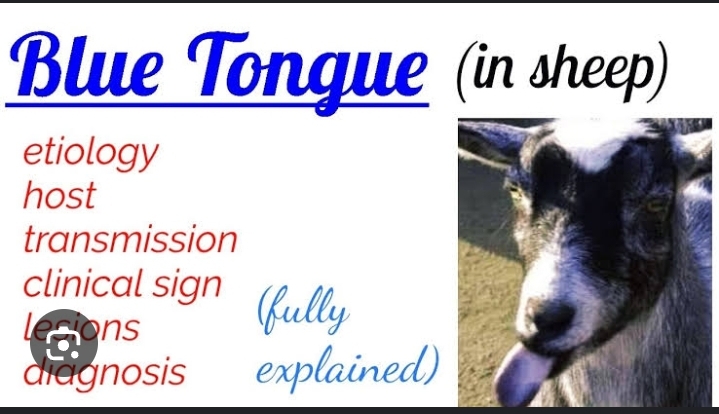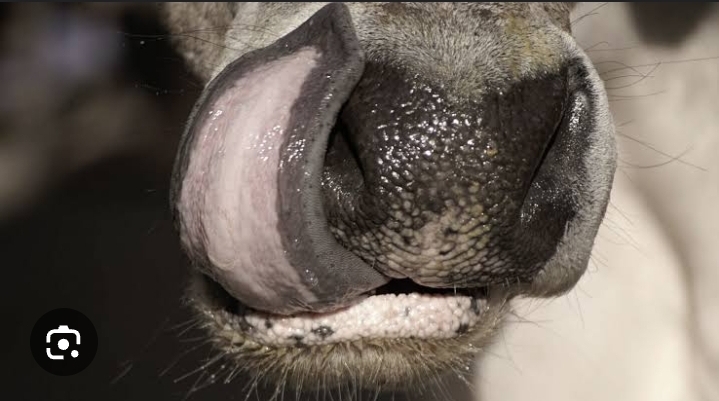Animal Diseases ControlAnimal Health TechnicianAnimal Vaccinations
Bloutongue: Learn More on How is Bluetongue disease affecting Livestock Animals

Bluetongue disease in sheep and cattle, covering its causes, transmission, clinical signs, pathogenesis, diagnosis, treatment, prevention, and economic impact.
1. Cause of Bluetongue:
Bluetongue disease is caused by the Bluetongue virus (BTV), a non-contagious, insect-transmitted virus from the genus Orbivirus within the family Reoviridae.
- There are at least 27 known serotypes of BTV, and immunity is serotype-specific.
- The virus replicates in endothelial cells, leading to vascular damage.
2. Transmissio of Bluetongue:
- Vector-borne disease: Transmitted primarily through the bite of infected female midges, especially those of the Culicoides genus.
- The midges become infected after feeding on viremic animals and then transmit the virus to other susceptible hosts.
- Transmission is seasonal, often peaking in late summer and autumn.
- Vertical transmission (from dam to fetus) and mechanical transmission (through contaminated needles) can occur but are rare.

3. Host Range in Bluetongue:
- Sheep: Most susceptible and show severe clinical disease.
- Cattle: Reservoir hosts; often asymptomatic but carry the virus longer.
- Goats, deer, and wild ruminants: Can be infected; severity varies.
4. Clinical Signs of Bluetongue:
In Sheep:
- Acute febrile disease
- Facial edema (swelling), especially around the lips and eyes
- Cyanosis (blue coloration) of the tongue (a hallmark but not always present)
- Ulceration and hemorrhages in the mouth and nose
- Nasal discharge and drooling
- Difficulty breathing
- Lameness due to inflammation of the coronary band
- Abortions and congenital malformations
- Death in severe cases

In Cattle:
- Mostly subclinical
- Occasionally:
- Fever
- Erosive or ulcerative lesions in the mouth
- Hyperemia of the teats
- Reduced milk yield
- Abortions and fetal abnormalities
5. Pathogenesis found in Bluetonguedisease:
- BTV primarily targets endothelial cells lining blood vessels.
- Results in vascular damage, increased permeability, hemorrhage, and tissue necrosis.
- Leads to edema, mucosal erosion, and inflammation of the skin and mucous membranes.
- In fetuses, the virus can cross the placenta, causing hydranencephaly or cerebellar hypoplasia.

6. Diagnosis through Bluetongue disease:
- Clinical signs and history (especially season and presence of midges)
- Laboratory tests:
- PCR (Polymerase Chain Reaction): Detects viral RNA
- ELISA (Enzyme-Linked Immunosorbent Assay): Detects antibodies
- Virus isolation and serotyping: For detailed epidemiological studies
7. Treatment of Bluetongue disease:
- No antiviral treatment
- Supportive therapy:
- Anti-inflammatory drugs
- Antibiotics to prevent secondary infections
- Fluids and nutritional support
- Isolation of affected animals to prevent midge bites

8. Prevention and Control Measuresof Bluetongue:
- Vaccination:
- Live attenuated vaccines: Effective but may have risks (e.g., reversion to virulence, transmission by midges)
- Inactivated vaccines: Safer, but multiple doses are needed
- Vaccines are serotype-specific – proper matching is crucial
- Vector control:
- Reduce exposure to midges (housing animals indoors at dusk and dawn)
- Use of insecticides or repellents
- Drain standing water to reduce breeding sites
- Surveillance and movement control:
- Monitoring and reporting outbreaks
- Restricting animal movements during outbreaks
LEARN MORE ABOUT OTHE ANIMAL DISEASES LIKE FOOT & MOUTH
Also Read About: Available Vacancies
9. Economic Impact on Bluetongue:
- Major economic losses in sheep farming due to:
- Mortality
- Reduced productivity (wool, meat, milk)
- Trade restrictions and quarantine measures
- Costs of vaccination and vector control
- Can impact international trade due to disease status
That was the impact overview of the Bluetongue disease in sheep and cattle, covering its causes, transmission, clinical signs, pathogenesis, diagnosis, treatment, prevention, and economic impact.



